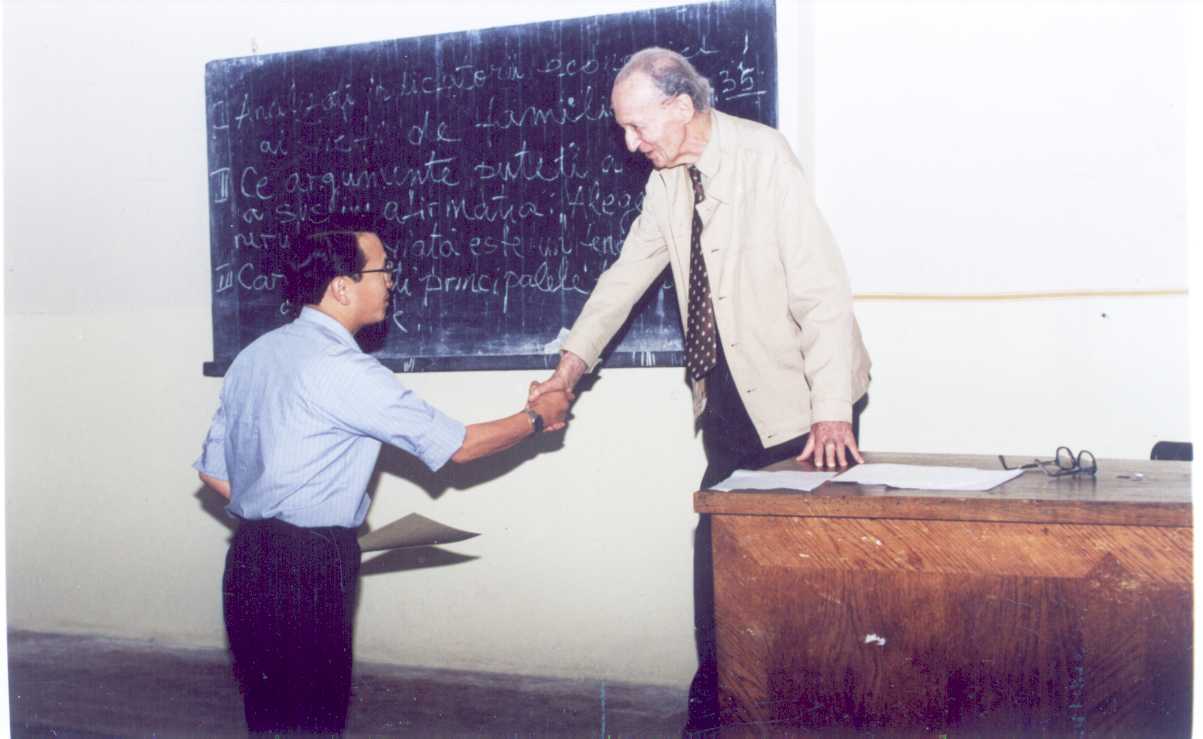For Excellence in Non-Crystalline Chalcogenides
Year 2001
Dear Colleagues,
I have the pleasure to open the Forum of Chalcogeniders in the frame of the First International Workshop on Amorphous and Nanostructured Chalcogenides. At the dawn of the third millenium we all have the privilege to participate to one of the largest meetings of those who dedicated their activity to the fundamentals and applications of non-crystalline chalcogenides, prospective materials for optoelectronics. Along four days, we will have the occasion to discuss the latest developments in the filed, to exchange ideas, to elaborate plans, to open new cooperations between teams from different countries, and, last but not least, to make new friends. Physicists, chemists and engineers from 20 countries (103 participants) take part into this Workshop.
Two awards have been founded to this occasion: The Award Boris T. Kolomiets for the best paper presented in this Workshop and the Award Stanford R. Ovshinsky for Excellence in Non-Crystalline Chalcogenides (to be granted on an annually basis). The last one was enthusiastically supported by Stan Ovshinsky who regret very much not to be able to participate in our Workshop and to hand personally the Award to the winner. Stan is now very busy with the implementation of his inventions based on amorphous materials.
While the winner of the B. T. Kolomiets Award will be decided by your secret voting, for the Ovshinsky Award, an International Jury has been nominated (after the suggestion of Stan).
Note added at the end of the Workshop: The B. T. Kolomiets Award for the best paper of the Workshop has been won by Prof. P. Boolchand (University of Cincinnati, Ohio, USA) with the paper: Discovery of the intermediate phase in chalcogenide glasses, authors: P. Boolchand, D. D. Georgiev, B. Goodman/published in J. Optoelectron. Adv. Mater. 3(3), 703-720, 2001.
The Jury of the Ovshinsky Award, 2001
- Ishwar Aggarwal
- Punit Boolchand
- Stephen Elliott
- P. J. S. Ewen
- Miloslav Frumar
- Alexander Kikineshi
- Alexander Kolobov
- Himanshu Jain
- Gerald Lucovsky
- Victor Lyubin
- Maria Mitkova
- Piet Nagels
- Koichi Shimakawa
- Keiji Tanaka
- Elena Vateva
The winners of the Ovshinsky Award for 2001 are, ex aequo:
and
Prof. Keiji Tanaka, Hokkaido University, Sapporo, Japan

The winners have been validated by Stanford R. Ovshinsky.
Professor Stephen R. Elliott started his scientific career in the amorphous semiconductors in the years '70, the period that these materials became very popular.
In 1977 he published his theory on bipolaron correlated barrier hopping for the explanation of the a.c. conductivity in chalcogenide glasses. This model is a combined variable-energy and variable-range hopping model, which is still used until now. In 1984 he published an excellent book on the "Physics of the Amorphous Materials", which can be considered as a standard work for all scientists working in the field of amorphous materials. For many years he published excellent works in the structural characterization of chalcogenides by EXAFS and other techniques.
A large part of his career was devoted to the studies of metastabilities, in particular the photoinduced isotropic and anisotropic changes in amorphous chalcogenides. He proposed a unified model for reversible photostructural changes in chalcogenide glasses in terms of the scission of bonds, both intermolecular and intra-molecular. This work was an important step in the understanding of the reversible photo-induced phenomena.
He is a good speaker and can deliver exciting talks.
(text by P. Nagels)
Professor Keiji Tanaka has been working in the field of glassy chalcogenides
starting from early 70-th. Detailed experimental study of photoinduced
change of optical parameters in chalcogenide films with variable
compositions, fulfilled by K. Tanaka and his co-workers, resulted in the
development of configuration-coordinate model explaining many peculiarities
of photodarkening and photorefraction phenomena in different glassy
chalcogenides. Many important results were obtained at investigation of
photoexpansion of As2S3 films.
Pioneering research of stress-induced anisotropy in chalcogenide glasses,
made by Tanaka, was followed by investigation of photoinduced anisotropy in
bulk and film chalcogenide samples. One of the main conclusions of these
studies claims that in opposite to crystals, for which the natural anisotropy
is characteristic, the chalcogenide glasses offers anisotropy that can be
artificially controlled.
Very serious contribution was made by Prof. Tanaka and his colleagues
in the study of the so-called photodoping of chalcogenide glass by silver
and of photo-electro-ionic phenomena in the ion-conducting amorphous
semiconductors. Recently, they observed and studied a macroscopic pattern
formation in the ion-conducting chalcogenide glasses excited by focused
laser beam.
Another important result was the discovery of the photoinduced
fluidity in chalcogenide glasses.
Together with the fundamental research, the small part of which is
considered above, professor Tanaka obtained many important results in the
field of applied physics. The photoinduced Bragg reflectors, which can be
reversibly induced and erased in As2S3 bulk glasses, the microlens arrays
fabricated in different chalcogenide glasses, the chalcogenide film based
microlenses for optical fibers are the examples of optoelectronic devices
developed in the group of Prof. Tanaka.

